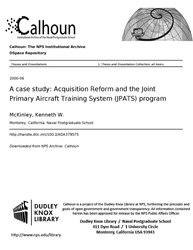File:A case study- Acquisition Reform and the Joint Primary Aircraft Training System (JPATS) program (IA acasestudyacquis109459296).pdf

Original file (1,275 × 1,650 pixels, file size: 4.44 MB, MIME type: application/pdf, 121 pages)
Captions
Captions
Summary[edit]
| A case study: Acquisition Reform and the Joint Primary Aircraft Training System (JPATS) program
( |
||
|---|---|---|
| Author |
McKinley, Kenneth W. |
|
| Title |
A case study: Acquisition Reform and the Joint Primary Aircraft Training System (JPATS) program |
|
| Publisher |
Monterey, California. Naval Postgraduate School |
|
| Description |
Defense Acquisition Pilot Programs (DAPPs) were established to jump- start the initiatives outlined in the Federal Acquisition Streamlining Act (FASA) of 1994. DAPPs were provided legislative authority to implement the provisions of FASA before they were published in regulations, authority to use the commercial item exemptions for non-commercial items and were also given expedited deviation authority from the FAR/DFARS and the DOD 5000 series regulations. The Joint Primary Aircraft Training System (JPATS) was designated a pilot program by the Deputy Under Secretary of Defense for Acquisition Reform. The purpose of this paper is to provide insight into the Joint Primary Aircraft Training System (JPATS) acquisition and describe, if any, the results of acquisition reform on program effectiveness, cost, schedule, and performance. Eleven metrics were established by the JPATS program and then measured against established baseline programs to derive quantitative savings attributed to implementing acquisition reform. An analysis of those metrics concludes acquisition reform is having mixed results on this program. Only two measures seem successful indicators of acquisition reform, while the remaining nine seem to indicate more success is being realized from applying acquisition program management reform efforts highlighted in DOD directives than statutory and regulatory relief provided DAPPs. Subjects: acquisition reform; major weapon systems; acquisition stremling |
|
| Language | English | |
| Publication date | June 2000 | |
| Current location |
IA Collections: navalpostgraduateschoollibrary; fedlink |
|
| Accession number |
acasestudyacquis109459296 |
|
| Source | ||
| Permission (Reusing this file) |
This publication is a work of the U.S. Government as defined in Title 17, United States Code, Section 101. Copyright protection is not available for this work in the United States. | |
Licensing[edit]
| Public domainPublic domainfalsefalse |
This work is in the public domain in the United States because it is a work prepared by an officer or employee of the United States Government as part of that person’s official duties under the terms of Title 17, Chapter 1, Section 105 of the US Code.
Note: This only applies to original works of the Federal Government and not to the work of any individual U.S. state, territory, commonwealth, county, municipality, or any other subdivision. This template also does not apply to postage stamp designs published by the United States Postal Service since 1978. (See § 313.6(C)(1) of Compendium of U.S. Copyright Office Practices). It also does not apply to certain US coins; see The US Mint Terms of Use.
|
 | |
| This file has been identified as being free of known restrictions under copyright law, including all related and neighboring rights. | ||
https://creativecommons.org/publicdomain/mark/1.0/PDMCreative Commons Public Domain Mark 1.0falsefalse
File history
Click on a date/time to view the file as it appeared at that time.
| Date/Time | Thumbnail | Dimensions | User | Comment | |
|---|---|---|---|---|---|
| current | 20:14, 13 July 2020 |  | 1,275 × 1,650, 121 pages (4.44 MB) | Fæ (talk | contribs) | FEDLINK - United States Federal Collection acasestudyacquis109459296 (User talk:Fæ/IA books#Fork8) (batch 1993-2020 #5064) |
You cannot overwrite this file.
File usage on Commons
The following page uses this file:
Metadata
This file contains additional information such as Exif metadata which may have been added by the digital camera, scanner, or software program used to create or digitize it. If the file has been modified from its original state, some details such as the timestamp may not fully reflect those of the original file. The timestamp is only as accurate as the clock in the camera, and it may be completely wrong.
| Short title |
|
|---|---|
| Author | McKinley, Kenneth W. |
| Date and time of digitizing | 14:01, 4 August 2000 |
| Software used | tif_convert_2_ps() |
| File change date and time | 04:28, 8 July 2011 |
| Date metadata was last modified | 04:28, 8 July 2011 |
| Conversion program | Acrobat Distiller Daemon 3.01 for Solaris 2.3 and later (SPARC) |
| Encrypted | no |
| Page size | 612 x 792 pts (letter) |
| Version of PDF format | 1.4 |

